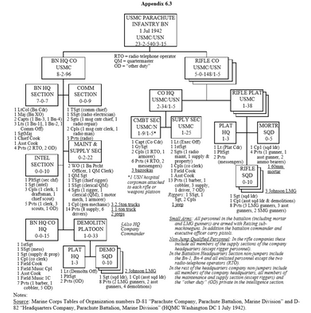U.S. Marine Parachute Platoon (WWII)
- Battle Order
- Mar 6, 2019
- 8 min read
Updated: May 16, 2022
Timeframe Included: 1941, 1942, 1943
The fabled U.S. Marine Corps paratroopers of World War II, colloquially known as “paramarines,” are often overlooked in the conversation about early airborne military forces. Although they were arguably less impactful than their Army counterparts and definitely not employed to the same degree, they are no doubt interesting from a historical perspective.
Unlike in the European Theatre where the U.S. Army participated in several division and corps-sized airborne operations, the Pacific were not as conducive to such large scale drops. Thus, the Army only ever conducted regiment-sized parachute operations in the Pacific - notably at the hands of the 503rd and 511th Parachute Infantry Regiments. The Marine Corps, meanwhile, never deployed their parachute regiment from the air, rather employing them as regular infantry and eventually deactivating it in February 1944.
This article aims to detail the organization of the U.S. Marine Parachute Platoon during the war based upon Table of Organization No. D-81 and D-82, accounts from officers of the Marine parachute battalions, and other secondary evidence. Additional resources about the company and battalion organization will also be included.
The Parachute Squad
American parachute forces have typically enjoyed a greater amount of firepower at lower levels than their infantry counterparts. The assumption is that during airborne operations, airborne forces would inevitably become scattered and take heavy casualties. Thus, it might have not be incredibly useful if all of the platoon’s machine guns were in a specialized unit that may never have been able to link up with the rest of their unit. Additionally, because airborne forces often operate in isolation without immediately available ground support, it becomes essential to be able to project as much firepower as possible to make up for a lack of heavy weapons.
The Army’s solution to this was issuing M1919A4 (later A6) belt-fed medium machine guns directly to their parachute infantry squads. By July 1942, the Marines wanted to issue their parachute squads with 3 M1941 Johnson light machine guns (compared to 1 M1918A2 BAR in regular Marine squads) and the remainder with M55 Reising submachine guns (a novelty in a service where most Marines were still armed with M1903 bolt-action rifles).
The Johnson light machine gun was a common choice, as well as the official light machine gun from 1942, of the Paramarines. It was lighter than the BAR and had an easily detachable barrel, making it ideal for airborne operations. The M55 Reising was chosen because it was compact, with a side-folding wire stock, and was cheaper and more available than the Thompson early in the war. However, due to availability, the M50 Reising may have also been used (confirmed by photographic evidence). Thus, either the M55 or M50 would be correct.
The following is the official organization of the parachute rifle squad as of 28 March 1941 (T/O D-81) prior to the U.S.’s entry into World War II:
Parachute Rifle Squad (28 March 1941)
1× Squad Leader, a Sergeant, armed with 1 M55 Reising submachine gun (to be substituted with an M1928A1 Thompson if Reisings were unavailable) and 1 M1911A1 pistol
1× Assistant Squad Leader, a Corporal, armed with 1 M55 Reising submachine gun (to be substituted with an M1928A1 Thompson if Reisings were unavailable) and 1 M1911A1 pistol
2× Automatic Riflemen, Privates, armed with 1 M1918A2 BAR and 1 M1911A1 pistol each
2× Assistant Automatic Riflemen, Privates, armed with 1 M1903 Springfield rifle and 1 M1911A1 pistol each
4× Riflemen, Privates, armed with 1 M1903 Springfield rifle and 1 M1911A1 pistol each
Although only allotted 2 BARs according to the TO&E, there was a surplus of them available to the 1st Parachute Battalion while training at Camp Lejeune in 1941. According to History of U.S. Marine Corps Operations in World War II (p. 698), at this time, the battalion’s rifle squads were divided into 3 3-man fire teams led by the squad leader. Presumably, the assistant squad leader would act as one of the fire team leaders, while the other two would be led by one of the more capable privates.
Thus, we can extrapolate the following organization and equipment for the nominal rifle squad within the 1st Parachute Battalion:
1st Parachute Battalion Rifle Squad (March 1941):
1× Squad Leader, Sergeant, armed with 1 M55 Reising and 1 M1911A1
3× Fire Teams Consisting of:
1× Fire Team Leader, Private or Corporal, armed with 1 M55 Reising and 1 M1911A1
1× Automatic Rifleman, Private, armed with 1 M1918A2 BAR and 1 M1911A1
1× Submachine Gunner, Private, armed with 1 M55 Reising and 1 M1911A1
Like the early 1941 organization of the U.S. Army Parachute Infantry rifle squad, every member was armed with a pistol. This is presumably so paratroopers would have a back-up weapon if isolated - especially if they became separated from their primary weapons. This was fairly common practice for early paratroopers and special forces, with the most famous example being the German Fallschirmjäger which issued all members of their squads pistols because their primary weapons were dropped separately in canisters. The joint American-Canadian First Special Service Force would carry this concept in 1944, while regular Army airborne dropped it by 1942.
Although the Reising was much reviled by the Marines who used them on Guadalcanal, it was much more available than the Thompson submachine gun, and the M55 specifically was the most compact submachine gun available to the Paramarines at the time.
There was an organizational update on 10 January 1942 (T/O D-81) shortly following the attack on Pearl Harbor. The squad organization was changed to the following:
Parachute Rifle Squad (10 January 1942)
1× Squad Leader, a Sergeant, armed with 1 M55 Reising submachine gun
1× Assistant Squad Leader, a Corporal, armed with 1 M55 Reising submachine gun
1× Automatic Rifleman, Privates, armed with 1 M1941 Johnson light machine gun and 1 M55 Reising submachine gun
1× Assistant Automatic Riflemen, Privates, armed with 1 M55 Reising submachine gun
6× Submachine Gunners, Privates, armed with 1 M55 Reising submachine gun each
This structure was more similar to the standard U.S. Marine Corps rifle squad structure at the time, which consisted of 9 men with one BAR and 8 M1903 Springfield rifles (the obvious difference being the prevalence of folding-stock Reisings among the Paramarines). However, this was a downgrade in firepower and would ultimately be short lived, as the parachute infantry structure would again be altered 6 months later in July 1942.
There were variations in equipment between the battalions depending on the time period. The following organization for the squad was effective as of 1 July 1942 (T/O D-81) and is what was likely used by the 1st Parachute Battalion which was engaged in combat on Guadalcanal and associated diversionary raids:
Parachute Rifle Squad (1 July 1942)
1× Squad Leader, a Sergeant, armed with 1 M55 Reising submachine gun
1× Assistant Squad Leader, a Corporal, armed with 1 M55 Reising submachine gun
3× Automatic Rifleman, Privates, armed with 1 M1941 Johnson light machine gun and 1 M55 Reising submachine gun each
3× Assistant Automatic Riflemen, Privates, armed with 1 M55 Reising submachine gun each
2× Submachine Gunners, Privates, armed with 1 M55 Reising submachine gun each
Based on the 1st Battalion’s use of the fire team system in 1941, it can be assumed that this squad would be divided into 3 fire teams of 3 men (each led by a Fire Team Leader and including an Automatic Rifleman and Assistant Automatic Rifleman) with the Squad Leader overseeing the fire team leaders.
According to weapons inventory data published by USMCweaponry.com, at the time of the Guadalcanal landings, the 1st Battalion had 92 Reising submachine guns, 79 M1903 rifles, 18 Johnson light machine guns, and 3 BARs on hand. Given how small the number of weapons is, it is uncertain whether this is the amount of weapons held in reserve, or the total weapons of the battalion on hand after taking heavy casualties on Guadalcanal. However, it can still be assumed that the average rifle squad was equipped with M55 Reisings (possibly sometimes substituted with Springfields, but I have not confirmed this) and Johnson light machine guns.
Meanwhile, the 2nd Battalion, which was not deployed until October 1943 on Choiseul Island and later Bougainville, had 62 Reisings, 650 Johnson rifles, 109 Johnson light machine guns, and no Springfields or BARs on hand in November 1942. Like the 1st Battalion, the 2nd Battalion also used squad layout consisting of 3 3-man fire teams built around a light machine gun. Based on a memo written by Lt. Col. Victor H. Krulak (commander of the 2nd Battalion), his battalion made exclusive use of the Johnson LMG, which matches weapon inventory records.
Thus, based on the evidence presented, the following squad organizations can be extrapolated for the 1st and 2nd Parachute Battalions just prior to Guadalcanal:
1st Parachute Battalion Rifle Squad (July 1942):
1× Squad Leader, a Sergeant, armed with 1 M55 Reising
3x Fire Teams Consisting of:
1× Fire Team Leader, a Corporal (also assistant squad leader) or Private, armed with 1 M55 Reising
1× Automatic Rifleman, a Private, armed with 1 M1918A2 BAR
1× Assistant Automatic Rifleman, a Private, armed with 1 M55 Reising
2nd Parachute Battalion Rifle Squad (July 1942):
1× Squad Leader, a Sergeant, armed with 1 M55 Reising or M1941 Johnson Rifle
3x Fire Teams Consisting of:
1× Fire Team Leader, a Corporal (also assistant squad leader) or Private, armed with 1 M1941 Johnson Rifle
1× Automatic Rifleman, a Private, armed with 1 M1941 Johnson Light Machine Gun
1× Assistant Automatic Rifleman, a Private, armed with 1 M1941 Johnson Rifle
Following the 1st Battalion’s action on Guadalcanal, it was pulled out of combat and brought back to the states to refit and train. During this time, its M55 Reisings would largely be ditched in favor of M1941 Johnson rifles, according to the text Silk Chutes and Hard Fighting. Thus, Bougainville and the New Georgia campaign would be the first actions where the M1941 Johnson rifle would see major combat use by the Paramarines, while the M1941 Johnson light machine gun was used on Guadalcanal as well.
There was one final alteration to the official TO&E before the Paramarines’ dissolution made 12 February 1943 (T/O D-315). Given that it has been established that the Paramarines used the fire team system well before the rest of the Marine Corps (something it did in league with the 2nd Raider Battalion), the following organization may be extrapolated.
Parachute Rifle Squad (February 1943):
1× Squad Leader, a Sergeant, armed with 1 M55 Reising (likely substituted by a Johnson rifle unofficially)
3x Fire Teams Consisting of:
1× Fire Team Leader, a Corporal (assistant squad leader and demolitions specialist) or Private, armed with 1 M55 Reising (likely substituted by a Johnson rifle unofficially)
1× Automatic Rifleman, a Private, armed with 1 Johnson Light Machine Gun
1× Assistant Automatic Rifleman, a Private, armed with 1 M55 Reising (likely substituted by a Johnson rifle unofficially)
Given that it is known that the 2nd Battalion was entirely outfitted with the Johnson rifle and the 1st Battalion replaced their Reisings with Johnsons after Guadalcanal, it is very likely that the Reising would have been almost universally substituted by an M1941 Johnson rifle, or the also available M1 Garand rifle, M1 Carbine or M1 Thompson (although this is also unconfirmed).
The Parachute Platoon
At the inception of the first Paramarine organization in March 1941, the Parachute Platoon consisted a platoon headquarters and 3 rifle squads (detailed above). The platoon headquarters consisted of:
1× Platoon Commander, a 2nd or 1st Lieutenant, armed with 1 M1911A1 pistol
1× Platoon Sergeant, a Platoon Sergeant (predecessor to the Staff Sergeant rank amongst infantry), armed with 1 M55 Reising (nominal) or M1928A1 Thompson (substitute) submachine gun and 1 M1911A1 pistol
2× Messengers, Privates, armed with 1 M55 Reising or M1928A1 Thompson submachine gun and 1 M1911A1 pistol each
The organization of the platoon headquarters did not fundamentally change over the history of the Paramarines. However, there were the following equipment changes:
January 1942 - The Platoon Commander’s pistol was replaced with a submachine gun and all other pistols in the platoon headquarters were removed
February 1943 - All submachine guns were replaced with M1A1 Carbines as they became available
Aside from the platoon headquarters and 3 rifle squads which stayed a part of the parachute platoon throughout its history, an integral mortar squad was added to the platoon in July 1942. This squad served one M2 60mm mortar. This was similar to the U.S. Army Parachute Infantry platoon, which also carried an integral 60mm mortar squad in each platoon (as opposed to having a mortar team attached to the company headquarters or as a section in the company weapons platoon as was customary in the regular Army and Marines).
At the time, the mortar squad consisted of:
1× Squad Leader, a Corporal, armed with an M55 Reising
1× Mortar Gunner, a Private, armed with an M55 Reising
1× Assistant Mortar Gunner, a Private, armed with an M55 Reising
2× Ammunition Bearers, Privates, armed with an M55 Reising each
Like the platoon headquarters, the mortar squad’s organization did not change. However, in February 1943, all Reisings were replaced with M1A1 Carbines.
At the time of dissolution, the Marine Parachute Infantry Rifle Platoon consisted of 1 officer and 37 enlisted men organized thusly:
Platoon Headquarters, 1 officer and 3 enlisted men
Mortar Squad, 4 enlisted men and a 60mm mortar
3× Rifle Squads, 10 enlisted men and 3 Johnson LMGs each
The higher company and battalion level organizations for the Paramarines are visualized below, with the charts sourced from the appendix of Battalion: An Organizational Study of the United States Infantry (2000):






























